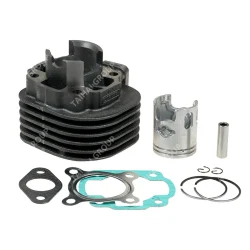How to Properly Install a Cylinder Block Kit for Optimal Engine Performance
2024-09-21
Installing a cylinder block kit can significantly improve the performance and lifespan of your engine. Whether you're a DIY enthusiast or a professional mechanic, understanding the installation process is crucial for a successful rebuild. In this blog, we’ll walk you through the key steps involved in installing a cylinder block kit.
Step 1: Pre-Installation Preparation
Before you begin, it's essential to gather all necessary tools and parts. This includes:
- Your new cylinder block kit
- A torque wrench
- Cleaning solutions (to ensure parts are free of debris)
- Sealants and lubricants
Ensure the workspace is clean and free of contaminants that could affect the installation process.
Step 2: Inspect and Clean the Components
Even though your cylinder block kit is new, it’s always a good idea to inspect all the components for any damage. Next, clean the block and related components using appropriate cleaning solutions. This step ensures that debris or leftover gaskets from previous installations won’t affect the new setup.
Step 3: Prepare the Engine
Drain the engine oil and remove all parts connected to the old block, including the cylinder head, intake manifold, and exhaust manifold. This allows you to access the cylinder block itself. Take your time during disassembly, labeling parts as needed to ensure a smooth reassembly process.
Step 4: Install the New Cylinder Block
Position the new cylinder block into the engine bay, aligning it with the crankshaft. Secure the block using bolts provided in the kit, ensuring each is torqued to the manufacturer’s specifications. The use of a torque wrench is critical here to avoid over-tightening or under-tightening bolts, which could lead to engine issues later.
Step 5: Reassemble the Engine
Once the cylinder block is securely in place, begin reassembling the engine components in the reverse order of disassembly. This includes reinstalling the cylinder head, intake and exhaust manifolds, pistons, and other components. Be sure to replace any old gaskets and seals with those provided in the kit to ensure a tight seal.
Step 6: Test and Tune
After the installation is complete, refill the engine oil and coolant. Start the engine and listen for any unusual noises, which may indicate a problem. Take the car for a test drive, monitoring the engine’s performance. If everything runs smoothly, the cylinder block kit installation is a success!
Final Thoughts
Installing a cylinder block kit is a highly technical task but can be extremely rewarding. A properly installed kit can restore your engine’s performance, improve fuel efficiency, and extend the life of your vehicle. For best results, always refer to your vehicle’s manual or seek professional assistance if you’re unsure about any part of the process.



